
Mantidae is one of the largest families in the order of praying mantises, based on the type species Mantis religiosa; however, most genera are tropical or subtropical. Historically, this was the only family in the order, and many references still use the term "mantid" to refer to any mantis. Technically, however, "mantid" refers only to members of the family Mantidae, and not the 14 remaining families of mantises. Some of the most recent classifications have promoted a number of the mantid subfamilies to the rank of family, e.g. Iridopterygidae, Sibyllidae, Tarachodidae, Thespidae, and Toxoderidae, while other classifications have reduced the number of subfamilies without elevating to higher rank.

Empusidae is a family of plant-mimicking mantises, consisting of 10 genera, in two subfamilies. Unlike many other mantis families, the Empusidae are a monophyletic lineage. Empusidae mantises are ambush predators, with mouthparts adapted to feeding on other insects and small animals. The majority of Empusidae species are distributed throughout Africa, but they are also found in Southeast Asia and in the southern parts of Europe.

Eremiaphilidae is a small Old World family of praying mantids, based on the type genus Eremiaphila. As part of a major revision of mantid taxonomy, this family now contains the subfamily Tarachodinae, which includes tribes and genera previously placed in the now obsolete Tarachodidae.

Mantinae is a subfamily of praying mantids of the family Mantidae. It was authored by Hermann Burmeister in 1838.
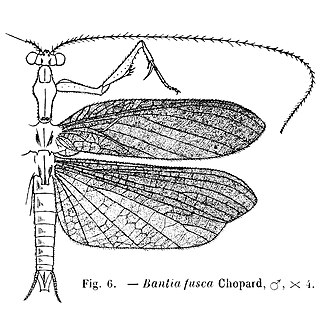
Thespidae is a family of insects in the order Mantodea. Following a major revision of this order in 2019, the old-world subfamilies Haaniinae and Hoplocoryphinae, previously placed here, have been upgraded to family level. Many genera are Neotropical, but the Thespinae are represented in Africa, Asia, Europe, and North America.

Iridopterygidae was a family of praying mantids in the order Mantodea whose members, having formerly been moved here as a subfamily within Mantidae, have now been transferred elsewhere as part of the recent (2019) major revision of mantid taxonomy.
Nanomantinae is a praying mantis subfamily in the new (2019) family Nanomantidae. The monotypic tribe Nanomantini was placed here, but several genera have been reassigned.
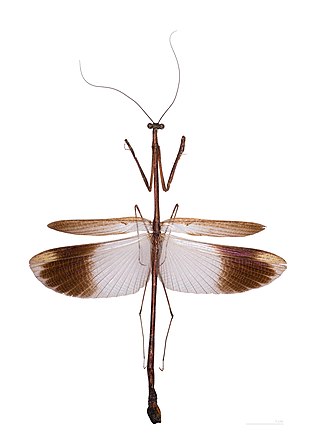
Angelidae is a family of mantises found in tropical Central and South Americas.
Epaphroditidae is a family of the Mantodea, containing species found in Africa and the Caribbean. Before 2015, it had been placed as the subfamily Epaphroditinae, in the Hymenopodidae, but is now excluded.

Iridopteryginae is a subfamily of mantises in the family Gonypetidae. There are two tribes, distributed in tropical Asia.

Tropidomantinae is a subfamily of mantises in the new (2019) family Nanomantidae. Within the single tribe Tropidomantini there are six genera, distributed in Asia and the Pacific.
Thespinae is a subfamily of mantises in the family Thespidae. There are 16 genera and at least 40 described species: found in most continents.
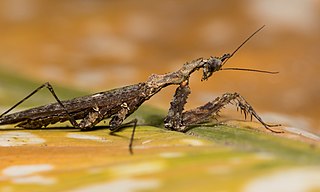
Haaniinae is a subfamily of mantises, now placed in the new (2019) family Haaniidae; the species can be found in Asia.
Nanomantini is a tribe of Asian mantises in the new (2019) family Nanomantidae. There are about 6 genera and 10 described species in Nanomantini.

The Hierodulinae are a subfamily of praying mantids, originally used by Brunner von Wattenwyl. It was restored as part of a major revision of mantid taxonomy, and now contains genera previously placed elsewhere in the family Mantidae.
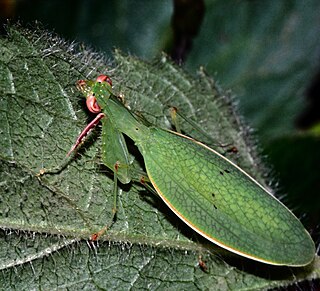
The Nanomantidae are a new (2019) family of praying mantises, based on the type genus Nanomantis. As part of a major revision of mantid taxonomy, genera and tribes have been moved here, substantially replacing the old family Iridopterygidae.

The Gonypetidae are a new (2019) family of praying mantids, based on the type genus Gonypeta. The name was created by Westwood and it has been revived as part of a major revision of mantid taxonomy; the subfamily Iridopteryginae having been moved here from the obsolete family Iridopterygidae. The Gonypetinae include Asian genera transferred from the obsolete taxa Amelinae and Liturgusidae.
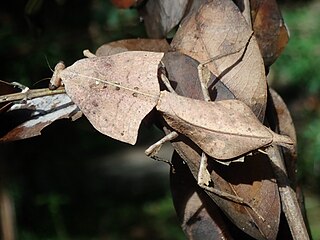
The Deroplatyidae are a new (2019) family of praying mantises, based on the type genus Deroplatys. As part of a major revision of mantis taxonomy, the subfamily Deroplatyinae has been moved here from the previously-structured family Mantidae.
Dactylopterygidae is a family of praying mantises, based on the type genus Dactylopteryx. The first use of "Dactylopterygidae" was by Giglio-Tos and it has recently (2019) been revived as part of a major revision of mantis taxonomy; three genera have been separated from others in the subfamily Liturgusinae and moved here from the family Liturgusidae.

Liturgusa is the type genus of praying mantises of the family Liturgusidae. The genus consists of more than twenty species with a Neotropical distribution.















